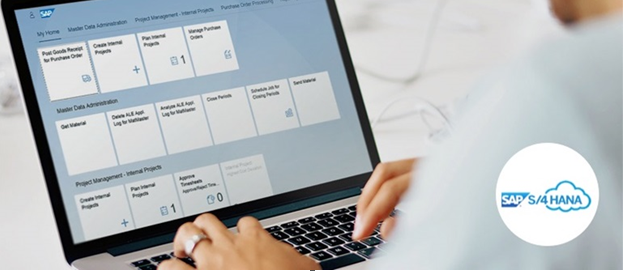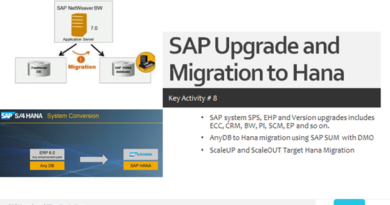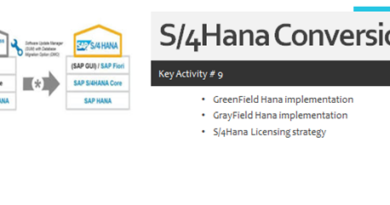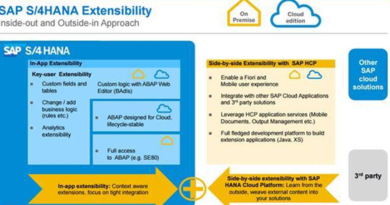SAP S/4 HANA
What is SAP HANA? – SAP HANA Basics
As we explained in What is SAP HANA, HANA is the backend that runs the SAP landscape. Its central feature is an innovative, column-based Relational Database Management System (RDBMS), which is used to store, retrieve and process data on core business activities.
SAP HANA itself doesn’t determine what sorts of tasks a business does — it can accommodate any type of data. Businesses install applications that run on top of HANA, such as SAP applications for finance, HR and logistics. As such, companies have to make choices about what software best meets their current needs.
The design of SAP HANA allows it to drastically boost speed for both Online Transaction Processing (OLTP) and Online Analytical Processing (OLAP). Most databases store the majority of their information on disk, and can only keep a limited amount of information in main memory; disk is relatively slow, which limits how fast the application can recall information. Because SAP HANA resides in-memory, it can retrieve, process and transmit data much more quickly.
SAP HANA also has a simpler architecture and lower memory footprint than other RDBMSs. In most competing systems, OLAP and OLTP are stored and processed in separate databases, which is inefficient, and leads to a lot of redundant information bloating the database footprint.
Additionally, most RDBMSs are oriented, and require indexes to speed up performance. SAP HANA, on the other hand, is column-oriented and combines OLAP and OLTP into a single structure, cutting memory usage by a factor of 10 or more and improving performance.
As a result, SAP HANA can do real-time analytics, crunching data nearly instantaneously. This allows businesses to react more quickly to changing conditions, providing significant strategic benefits.
SAP HANA isn’t just a new choice for enterprise computing; because it handles data very differently from other databases, it’s designed to run SAP software. By reworking their core ERP applications to better harness HANA’s speed and flexibility, SAP SE will only support older versions of the software until 2025. At that point, customers need to have completed their SAP HANA migration, and upgraded to the new software.
SAP ECC and Suite on HANA
SAP ECC, or Enterprise Central Component is the HANA enterprise suite used for ERP modules like logistics, warehousing, financing, and human resources.
There’s a lot of overlap between the terms ECC, R/3 and SAP ERP, which can cause confusion. The software developed from SAP R/3, which was first released in the early 90s. Starting with a 2003 release, the company started using the term “SAP ERP.” From 2004 on, the term “SAP ECC” was used more or less interchangeably with “SAP ERP.” Got all that? If not, don’t worry — for simplicity, we’ll stick with the term “SAP ECC.”
Because SAP ECC predates SAP HANA, companies using it generally started on other databases. When ECC users perform a SAP HANA migration without changing the application version to S/4 it becomes SAP Business Suite on HANA. This lets businesses benefit from the performance boost of SAP HANA without restructuring the application layer; the process is relatively simple, and users don’t have to adapt to a new system.
To ensure a great UX, we structure a user training plan depending on best practices, using our internal partners to help us identify the business benefits gained by using a train-the-trainer approach; a super-user “academy” or an IT-specific center of excellence (COE) that serves as a go-between for functional users and technical enablers. We can share several scenarios with you via our expert partners at United VARs to allow you to tailor the appropriate training approach that will work best for your organization.
SAP S/4HANA
SAP S/4HANA is SAP’s next generation business suite. It’s meant to replace SAP ECC/ERP, with a simplified tool designed specifically to work with SAP HANA. Currently, SAP is reworking the code behind the SAP ECC modules, optimizing them for the way the HANA database is set up. However, S/4HANA is an ongoing project. So far, SAP has reworked the finance module, and improved logistics as part of the core S/4HANA features. In other areas, the business benefits of S/4HANA over Business Suite on HANA are less significant.
ECC users may migrate to SAP HANA Business Suite first, or upgrade directly to S/4HANA. The databases and tables will have to be converted into the columnar structure of SAP HANA, with unneeded indices and aggregate tables removed. Additionally, applications designed or modified by the customer will need to be evaluated; in some cases, new HANA functionality may render them unnecessary, while in other cases, they may have to be adjusted to work properly with the new backend.
While preparing use cases, teams will first petition the IT team for the information they have on user business process activity. We will usually map these processes directly to SAP applications to ensure we’ve allocated them appropriately for load, memory and other sizing requirements.
Theoretically, “anyone” could perform this task, but at Timeline, our expertise resides in translating customer language into SAP language with a full awareness of different ways to engage with data in disparate company cultures. We examine which applications have been customized and ensure that they work appropriately with the new backend.
In most cases, you will need an SAP consultant to help you accurately do so. If you don’t, sizing activities are woefully inaccurate and you’ll have too much to fix after migration, along with frustrated user groups, inordinate amounts of downtime, or drastically reduced functionality. Change management techniques we’ve perfected over years will also protect and/or preserve (or in some cases, even improve) the IT-business user relationships after migration.
USING FIORI UX WITH S/4HANA
S/4HANA is designed to use Fiori UX. No matter what use cases are plotted during the fact-finding stage, customers can still use the old user interface during the transition; however, they’ll be able to take advantage of the power and flexibility offered in S/4HANA with Fiori. For some organizations, the current S/4 features may not outweigh the added complexity of moving past ECC. As time passes and new SAP S/4HANA functions are added, the benefits of Business Suite on HANA migration to S/4HANA increase for a greater range of organizations.
SAP ECC users may use SAP Fiori UX as a new way to view information. It does not replace the SAP GUI, but its standardized User Experience (UX) was based on innovative design using input from SAP customers. This UX gives a commercial-grade, design-focused feel to enterprise software. This is a radical departure from how SAP worked in the past. There are a wide range of Fiori apps, including:
- Transactional apps to perform tasks
- Analytical apps to simplify data analysis, and
- Fact sheets to show relationships between business objects
SAP Fiori apps are designed around the most common tasks users have to do, rather than the structure of the SAP modules themselves. This boosts productivity and ease of use, allowing users to choose and customize apps based on their roles and needs, rather than having to dive deep into SAP GUI to find the right tools.
ENHANCED FUNCTIONALITY, FEATURES, AND BENEFITS OF SAP S/4HANA
The greatest benefits of SAP S/4HANA over Business Suite on HANA lie in financial management and accounting. SAP S/4HANA Finance is designed to cover the full range of finance tasks, including planning, analysis, accounting, compliance and risk management. According to SAP chairman, HassoPlattner, the S/4HANA finance app can shrink data more than 10 fold, from 593 GB to 42 GB, “with only 8.4 GB being dynamic, current-year data requiring high availability and backups.”
Even more importantly, SAP S/4HANA Finance offers flexibility that Business Suite on HANA can’t match. Traditional databases are structurally complex, and designed to do certain types of analysis and reporting. To change the data flow, organizations have to rework the entire structure, which can require extensive reprogramming and testing.
Because SAP S/4HANA does away with the supporting data, it can also do away with the rigid structures. You can rapidly build models, predicting the effects of business decisions, such as divestment or acquisition. This flexibility allows predictive modeling, real-time cost and revenue analysis and cash flow optimization.
It also makes compliance and monitoring financials easier and quicker, by centralizing data and eliminating redundant information. Organizations aren’t forced to wait until the next close to get an in-depth look at financial KPIs — they can analyze data in real time over any range and at the desired depth, which provides better insight into the health of the company.
SAP S/4HANA Finance also allows companies to automate risk, compliance, international trade and other activities. By proactively minimizing risk and compliance violations, the software makes it easier to optimize business operations, protect assets, and improve financial performance. S/4HANA also provides real-time fraud detection, and can even predict and block future fraudulent behavior.
SAP S/4HANA Supply Chain provides compelling advantages over Business Suite on HANA in a range of logistics uses, including sales and procurement, inventory management and capacity planning. SAP S/4HANA allows real-time tracking of current inventory, transportation of goods, production costs and other data. Costs and profits are instantly reflected in accounting, providing better visibility into the company’s current finances.
S/4HANA logistics can even synchronize with mobile devices in individual trucks, automating invoicing and route planning, and posting problems such as missing goods. It also analyzes the flow of goods to reduce bottlenecks and help materials planners minimize inventory levels.
Moving to S/4HANA vs. Suite on HANA
Installing either SAP Business Suite on HANA or S/4HANA requires adjustment at the backend. SAP HANA is able to support all ECC functionality, but the different structure of the database necessitates good SAP Basis support, plenty of testing and backups, and some post go-live tweaking to ensure everything is working properly.
If your company has custom applications, legacy servers or multiple environments, it can further complicate things. An SAP partner with extensive SAP HANA migration experience can help you plan the best way to adapt complex or custom ERP environments to HANA. In many cases, HANA functionality can obviate the need to use custom code.
In any case, organizations will need to upgrade NetWeaver, adjust and tweak the new applications, and provide some additional training using S/4HANA applications and updates. Companies may also benefit from optimizing their ERP landscape (for example, by merging multiple SAP HANA Business Suite systems or migrating legacy systems to HANA), which adds extra complexity to the project.
Sizing the Environment with Expertise
According to SAP Insider, not sizing the hardware appropriately prior to migration will lead to poor response times and generally poor system performance. The SAP Quick Sizer tool is a good starting point; yet, one must still take the results from the Quick Sizer and make additional calculations to truly lock down the correct hardware configuration.
At Timeline, we have years of expertise in right-sizing the landscape. We can evaluate the SAP ecosystem among companies of all sizes and within all industries for the following elements:
- KPIs for peak and average loads
- Disk requirements
- Usage information for application deployments
- And many other KPIs, including those for database startup times,, input/output performance, data throughput and storage system latency
Making the Choice
SAP will continue to support and update ECC and Suite, allowing businesses to plan their SAP HANA migration and S/4 upgrade in a way that makes sense to them. Good planning can maximize strategic benefits, while minimizing disruptions.
For most SAP ECC users, the best bet is to start with SAP Business Suite and save S/4HANA for another project. It provides many key benefits of S/4HANA, and is simpler, less expensive and less disruptive. However, for companies in finance industries — and, to a lesser extent, logistics — the advantage of S/4HANA may be profound enough to warrant the additional complexity of upgrading all at once.
For companies upgrading from a legacy or non-SAP system, SAP S/4HANA is usually the best bet. They’ll be building and migrating to a completely new system anyway, so there’s no benefits to moving to SAP Business Suite on HANA, and no disadvantage to moving to S/4HANA. For companies with a complex blend of SAP ECC and other ERP environments, however, the choice can be more complex, and a multi-phase project may make the most sense.
We completed a migration for New England Biolabs to improve the functionality of their SAP ECC 6.0 platform for production planning, eProcurement, and product costing. The need for a stable and scalable platform to support the rapidly evolving business became critical, especially when identifying use cases to ensure future growth. We helped them build a 9-month plan that allowed them to first upgrade to Suite on HANA and then continue to S/4HANA. This is a common migration plan for those who require production applications support during migration that’s cost effective, while also supporting the use cases and functions most crucial to business performance.
Your company’s attitude toward cloud and IT infrastructure upgrades is also a factor. If your organization is reluctant to take on big IT projects, migrating straight from SAP ECC to S/4HANA may make the most sense. In spite of the added complexity, at least you’re done in one fell swoop.
Get the Most Out of S/4HANA or SAP Business Suite on HANA Benefits
When it comes to migrating to ERP on HANA, the right business partner can make all the difference. Timeline’s experience in cloud and hosting, IT consulting and ERP managed services makes us the right partner for every step of your journey. From choosing between SAP Business Suite and S/4, to planning and executing your SAP HANA migration to tweaking and running your SAP HANA cloud post go-live, we can maximize the benefits of SAP ERP, while minimizes costs and disruptions. Contact us to learn more about how we can help you get the most out of HANA.





12,066 thoughts on “SAP S/4 HANA”